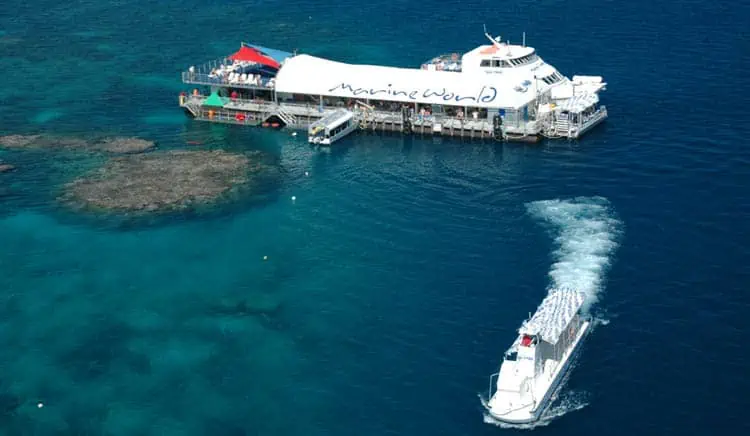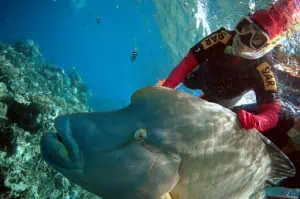The Great Barrier Reef

Although most of our holidays involve camping, we only had a few days and decided to fly up to Cairns and stay in a Resort. A first for me! I’m not one for organised tours, but the package put together by Reef Magic cruises looked pretty attractive. Having undertaken the Train trip to Kuranda, we were a little disappointed (the return trip on the Skyrail was excellent)and were looking for a real tropical experience. The Reef Magic tour was simply fantastic, and we enjoyed every minute.
The Package
The tour package includes snorkel, goggles, fins, and all the swimming you can ask for. An extra option we elected to take was a guided snorkel tour with a marine biologist. This is a beautiful way to have the intricacies of the Reef explained as you swim about.
– 5 hours at the Outer Barrier Reef Marine
– World Activity Platform offering shelter and shade, with showers and change rooms
– Underwater Observatory and fish feeding
– Marine Biology presentation
– Personalised and friendly service
– Unlimited snorkelling
– Dedicated Dive tender for certified divers
– Semi Submersible tours
– Morning and afternoon tea
– Hot and cold buffet lunch
Reef Magic
We left Cairns around 9 am on the high-speed Reef Magic catamaran. It took about 90 minutes to reach the Reef. The voyage out was a little sloppy, but once we moved onto the open water but most enjoyable. I had taken some Kwells as I suffer from seasickness, and they worked perfectly! We sat outside on the trip out and breathed the cool salt air to ensure I didn’t bring up breakfast. On the return trip, we sat inside the comfortable saloon, and I didn’t feel crook. Total bonus:)
Although there were quite a few people on board, the ratio of staff to passengers was high. Which meant we were well looked after. We arrived at the huge Marine World pontoon, moored on the Outer Reef. Immediately hopped aboard the semi-submersible for a tour of the Reef. Viewing the extraordinary array of coral and fish through the glass sides of the ‘submarine’ was an exciting way to begin our stay on the Reef.
During this excursion, we came upon the huge Wrasse nicknamed ‘Wally’, which you can see below. This huge fish swam right up and then moved off to follow the photographer as she took underwater snaps around the Reef. The marine biologist handed me a sea cucumber. She spoke about the varieties found along the Reef before carefully placing it back on the sea floor.
Our snorkelling exercise came a call for lunch, a hot and cold buffet, and excellent food quality. The helicopter buzzed overhead during lunch as people took a bird’s eye view of the Reef. We ventured back onboard the Reef Magic and finished lunch with a drink from the bar.
Great Barrier Reef Marine Park
The Great Barrier Reef is the world’s most extensive coral reef system, comprised of over 2,900 individual reefs and 900 islands stretching for 2,600 kilometres (1,600 miles) over an area of approximately 344,400square kilometres (133,000 sq miles). The reef is located in the Coral Sea, off the coast of Queensland in northeast Australia.
The Great Barrier Reef can be seen from outer space and is the world’s most significant single structure made by living organisms. This reef structure is composed of and built by billions of tiny organisms known as coral polyps. The Great Barrier Reef supports a wide diversity of life and, in 1981, became a World Heritage Site.
The Great Barrier Reef Marine Park protects a large part of the reef. This helps limit human use impacts, such as overfishing and tourism. Other environmental pressures on the reef and its ecosystem include water quality from runoff, climate change accompanied by mass coral bleaching, and cyclic outbreaks of the crown-of-thorns starfish.
Fish, Whales and Dolphins
The Great Barrier Reef supports a diversity of life, including many vulnerable or endangered species, some of which may be endemic to the reef system.

Six species of sea turtles come to the reef to breed. The green sea turtle, leatherback sea turtle, hawksbill turtle, loggerhead sea turtle, flatback turtle, and olive ridley. Around 125 species of shark, stingray, skates or chimera live on the reef. Close to 5,000 species of molluscs are recorded on the reef. Including the giant clam and various nudibranchs and cone snails.
Birds
Two hundred fifteen species of birds (including 22 species of seabird and 32 species off shorebirds) attracted to The Great Barrier Reef or nest or roost on the islands, including the white-bellied sea eagle and roseate tern. Seventeen species of sea snakes live on the Great Barrier Reef. They take three or four years to reach sexual maturity and are long-lived but with low fertility. More than 1,500 species of offish live on the reef. Including clownfish, red bass, red-throat emperor, and several species of snapper and coral trout. Forty-nine species are known to mass spawn, with eighty-four other species on the reef spawning elsewhere in their range.
Coral
Four hundred species of corals, both hard corals and soft corals, are found on the reef. Most of these spawn gametes, breeding in mass spawning events controlled by the rising sea temperatures of spring and summer, the lunar cycle, and the diurnal cycle. Reefs in the inner Great Barrier Reef spawn during the week after the full moon in October, but the outer reefs generate in November and December.
The common soft corals on the Great Barrier Reef belong to 36 genera. Five hundred species of marine algae or seaweed live on the Great Barrier Reef, including thirteen species of the Halimeda genus deposit calcareous mounds up to 100 metres (110 yds) wide. These create mini-ecosystems on their surface.







